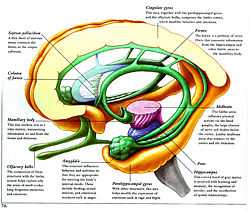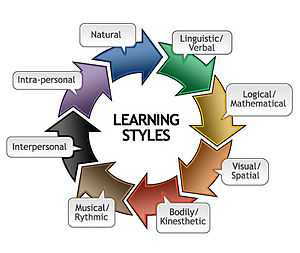Motivation and emotion/Book/2013/Emotion and learning
< Motivation and emotion < Book < 2013What role does emotion play in learning?
| |
This page is part of the Motivation and emotion textbook. See also: Guidelines. |
| |
Completion status: this resource is considered to be complete. |

|
|
Definition of Learning
The Oxford dictionary says learning is the acquisition of knowledge or skills through study, experience, or being taught:these children experienced difficulties in learning.
Definition of Emotion
The Oxford dictionary says emotion is a strong feeling deriving from one’s circumstances, mood, or relationships with others:she was attempting to control her emotions.
How the human brain learns?
Learning does not only depend on rationality
The Brain, Limbic System in particular the Amygdala

The Limbic System as displayed in this image is located in the center of the brain. The limbic system interprets the signals of the body to regulate emotions and behaviour.
As seen in the image on the left the Olfactory Bulb, Papahippocampal Gyrus, Cingulate Gyrus and Amygdala are critical areas in the development of emotion and are also areas utilized in learning new information and memory recovery.

Types of Learning
|
|

Classical Conditioning


Associative Learning
Behavioural Learning
|
|
Learning through Fear
|
|
Operant Conditioning
Observational


References
Bandura, A. (1969). Social-learning theory of identificatory processes.Handbook of socialization theory and research, 213, 262.
Cardinal, R. N., Parkinson, J. A., Hall, J., & Everitt, B. J. (2002). Emotion and motivation: the role of the amygdala, ventral striatum, and prefrontal cortex. Neuroscience & Biobehavioral Reviews, 26(3), 321-352.
Clark, J. C., & Groves, S. (2012).Teaching primary science: emotions, identity and the use of practical activities. The Australian Educational Researcher, 39(4), 463-475.
Gwen C. Marchand, Antonio P. Gutierrez. (2012) The role of emotion in the learning process: Comparisons between online and face-to-face learning settings, The Internet and Higher Education, 15(3), June 2012, 150-160.
Hu, H., Real, E., Takamiya, K., Kang, M. G., Ledoux, J., Huganir, R. L., & Malinow, R. (2007). Emotion enhances learning via norepinephrine regulation of AMPA-receptor trafficking. Cell, 131(1), 160-173.
Kay, R. H., & Loverock, S. (2008). Assessing emotions related to learning new software: The computer emotion scale. Computers in Human Behavior, 24(4), 1605-1623.
Killcross, S., & Place, P. (2000).The amygdala, emotion and learning. PSYCHOLOGIST-LEICESTER-, 13(10), 502-507.
Laviolette, S. R., Lipski, W. J., & Grace, A. A. (2005). A subpopulation of neurons in the medial prefrontal cortex encodes emotional learning with burst and frequency codes through a dopamine D4 receptor-dependent basolateral amygdala input. The Journal of neuroscience, 25(26), 6066-6075.
Pekrun, R., Goetz, T., Frenzel, A. C., Barchfeld, P., & Perry, R. P. (2011). Measuring emotions in students’ learning and performance: The Achievement Emotions Questionnaire (AEQ). Contemporary Educational Psychology, 36(1), 36-48.
Phelps,E.A. (2004) Human emotion and memory: interactions of the amygdala and hippocampal complexCurrent Opinion in Neurobiology, Volume 14, Issue 2, April 2004, Pages 198-202.
Rotter, J. B. (1954). Social Learning and clinical psychology. Englewood Cliffs, NJ: Prentic Hall.
External links
1.*Classical Conditioning- http://www.youtube.com/watch?feature=player_embedded&v=9hBfnXACsOI
2.*Operant Conditioning- http://www.youtube.com/watch?v=ZpSxJw0BFZs
3.